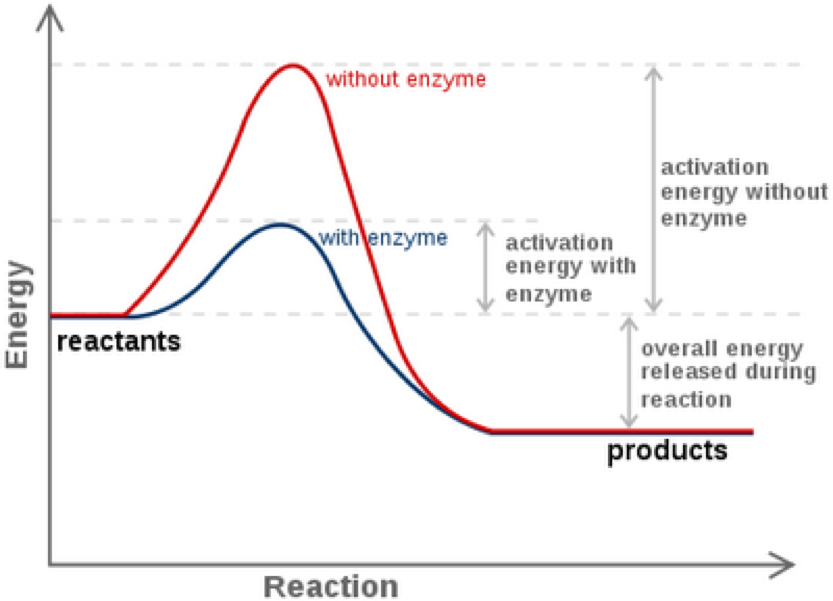Enzymes
0.0(0)
0.0(0)
Card Sorting
1/29
Earn XP
Description and Tags
An general overview of Enzymes and their functions!
Study Analytics
Name | Mastery | Learn | Test | Matching | Spaced |
|---|
No study sessions yet.
30 Terms
1
New cards
Temperature
________: pH and other environmental conditions that affect protein folding.
2
New cards
Substrate
________: Higher the concentration, the faster the rate until enzyme saturation occurs.
3
New cards
Enzymes
________ help speed up chemical reactions in the human body.
4
New cards
Remember metabolic reactions
Product: ________ are reversible so a high concentration of product can favor the reverse reaction.
5
New cards
Enzyme
________: Higher the concentration, the faster the rate until the substrate limits the reaction.
6
New cards
Enzymes
________ are proteins comprised of amino acids linked together in one or more polypeptide chains.
7
New cards
Competitive inhibition
Competitive inhibition is a type of enzyme inhibition in which an inhibitor binds to the active sites of an enzyme, preventing the substrate from binding to the enzyme
8
New cards
Non-Competitive Inhibition
Noncompetitive inhibition is a type of enzyme inhibition in which an inhibitor reduces the activity of an enzyme
9
New cards
Substrate
Higher the concentration, the faster the rate until enzyme saturation occurs
10
New cards
Product
Remember metabolic reactions are reversible so a high concentration of product can favor the reverse reaction
11
New cards
Temperature
pH and other environmental conditions that affect protein folding
12
New cards
Enzyme
Higher the concentration, the faster the rate until the substrate limits the reaction
13
New cards
pH
Enzyme activity is at its maximum value at the optimum pH
14
New cards
Predict the impact of Substrate on enzyme function
________: Higher the concentration, the faster the rate until enzyme saturation occurs.
15
New cards
What is the function of Enzymes?
________ help speed up chemical reactions in the human body.
16
New cards
Remember metabolic reactions
Product: ________ are reversible so a high concentration of product can favor the reverse reaction.
17
New cards
Predict and explain the impact Enzyme on Enzyme function
________: Higher the concentration, the faster the rate until the substrate limits the reaction.
18
New cards
Competitive inhibition
Competitive inhibition is a type of enzyme inhibition in which an inhibitor binds to the active sites of an enzyme, preventing the substrate from binding to the enzyme
19
New cards
Non-Competitive Inhibition
Noncompetitive inhibition is a type of enzyme inhibition in which an inhibitor reduces the activity of an enzyme
20
New cards
The impact of Product on enzyme function
Remember metabolic reactions are reversible so a high concentration of product can favor the reverse reaction
21
New cards
The impact of pH on enzyme function
Enzyme activity is at its maximum value at the optimum pH
22
New cards
The impact of Temperature on enzyme function
pH and other environmental conditions that affect protein folding
23
New cards
Enzyme's Function
Enzymes help speed up chemical reactions in the human body. They are essential for respiration, digesting food, muscle and nerve function, among thousands of other roles. There are different types of reactions that enzyme does.
24
New cards
Enzyme's structure
Enzymes are proteins comprised of amino acids linked together in one or more polypeptide chains. This sequence of amino acids in a polypeptide chain is called the primary structure. This, in turn, determines the three-dimensional structure of the enzyme, including the shape of the active site.
25
New cards
What is the allosteric site
Allosteric site is a region of an enzyme that allows activator or inhibitor molecules to bind to the enzyme that either activate or inhibit enzyme activity.
26
New cards
What is the active site
Active site is a region of an enzyme where substrate molecules bind and catalyze the reaction resulting in the production of particular products.
27
New cards
Explain the mechanism enzyme functioning
An enzyme attracts substrates to its active site, catalyzes the chemical reaction by which products are formed, and then allows the products to dissociate (separate from the enzyme surface). The combination formed by an enzyme and its substrates is called the enzyme–substrate complex.
28
New cards

Explain and illustrate enzyme impact on the rate of reactions
Enzymes will increase the rate of a chemical reaction by reducing the activation energy needed to make the reaction get started. Enzymes also speed up the rate of the reaction.
29
New cards
Competitive inhibition
Competitive inhibition is a type of enzyme inhibition in which an inhibitor binds to the active sites of an enzyme, preventing the substrate from binding to the enzyme.
30
New cards
Non Competitive Inhibition
Non Competitive Inhibition: Noncompetitive inhibition is a type of enzyme inhibition in which an inhibitor reduces the activity of an enzyme.